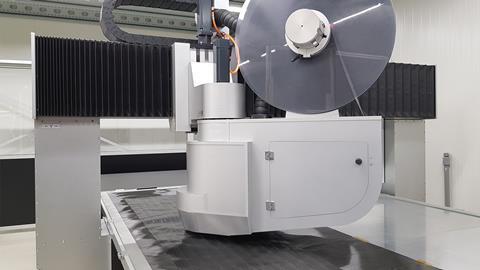Imagine if a company could reduce its manufacturing cycle time by 80 percent while upgrading the products it was building, decrease the weight of those products by as much as 50 percent compared to earlier iterations, incorporate sustainability improvements that could result in a fully recyclable product at the end of its lifespan and reduce cost. Those possibilities aren’t just impressive, they’re also attainable via advanced thermoplastic composite aerostructures for commercial aircraft.
Thermoplastic composites are well known as a plastic polymer material that becomes pliable or moldable at a certain elevated temperature and solidifies upon cooling. Thanks to their higher impact resistance, unique processing possibilities, lightweight properties, strength and environmental advantages, thermoplastic composites can help reduce fuel consumption while increasing environmental sustainability via reduced emissions. And Collins Aerospace is working hard to redefine the future by bringing more of these composites on board.

More energy-efficient manufacturing
When you narrow it down, thermoplastic composite technology plays an important role in energy efficiency. With traditional aircraft components made of bonded metallics and thermosets (or epoxy parts), the manufacturing process requires products to be cured in large autoclave ovens that consume large amounts of energy to get the necessary amount of heat and pressure.
In contrast, thermoplastic composites don’t require the same chemical reactions as thermosets so they can be manufactured via more efficient, out-of-autoclave processes that greatly reduce energy usage. With thermoplastics, manufacturing time can be reduced from hours to minutes while the material is shaped into its desired geometry. In addition, thermoplastic composites can be incredibly robust and more resistant to impact and high temperatures. In fact, when coupled with heat-protective coatings and ventilation, thermoplastic composites can even withstand the 3000-degree Fahrenheit temperatures found inside commercial aircraft engines.
“Not only is thermoplastics manufacturing quicker and more efficient, but it also has the potential to provide sustainability benefits because the resulting components and manufacturing waste are re-moldable and therefore recyclable – unlike metallic and thermoset parts,” said David Manten, general manager of Engineered Thermoplastics at Collins Aerospace. “With fuel efficiency ever more important to our aerospace customers, they’re counting on us for lighter-weight products – and thermoplastics can reduce the weight of structural components by up to 50 percent as compared to metallic solutions.”
Industry-leading thermoplastics portfolio
Today, Collins produces more than 2,000 different thermoplastic composite parts with hundreds of parts currently in qualification. Parts can be found on the fuselage, wing, tailplane, nacelles, flight control surfaces and doors, and are currently supplied to 20 different types of aircraft ranging from widebodies to single aisle, and business jets to helicopter platforms.
Through its acquisition of Dutch Thermoplastic Components (DTC) last year, Collins has for more than 20 years operated in the epicenter of thermoplastic composite technology. With a primary manufacturing and customer collaboration center in the Netherlands and a pilot line in the U.S., these two locations bring innovation for lightweight, aerospace parts ranging from small details to large assemblies at competitive pricing with a more sustainable footprint.
Going forward, Collins is leveraging this unique expertise as part of a broader initiative to develop a new level of advanced, in-house thermoplastics capabilities and a distinctive product portfolio for the benefit of current and future customers. The company is coordinating further advances across its global sites, and also collaborating with partners and research centers to build out its innovative capabilities in this space. Doing so will expedite the time to implement these technologies into the fleet and achieve the desired performance and environmental benefits.
“We’re looking to develop processes and capabilities that address not just traditional aerostructure components such as nacelles, but an expanded portfolio of interior structures and landing gear components to meet additional customer needs,” Manten said.
In-house manufacturing brings big benefits
“Collins has all of these capabilities in one research and development team – a one-stop shop, if you will, that is rare in the industry right now,” Manten explained. “Our sites boast concentrated know-how and capability with more than 100 highly specialized manufacturing specialists. Our overall footprint also features 20 research and development centers and about 70,000 square feet of manufacturing and office space.”
Because Collins’ thermoplastic composite manufacturing is retained in-house, the company provides customers with solutions that meet shorter lead times, are weight optimized and competitively priced. Using state-of-the-art machinery, automation and lean manufacturing principles, Collins’ production is suited not only for very small series of just a few straightforward parts, but also high-volume complex parts consisting of hundreds of parts per day.
“We’re proud of the fact that we have eight stamp forming presses, 10 computer numerical controlled (CNC) trim stations and have created more than 4,200 tools,” Manten said.
Building out the technological toolbox
The extensive toolbox of advanced thermoplastic technologies includes automated fiber placement (AFP), multiple advanced welding technologies, and large press stamp forming that allow Collins to build larger, more complex and fastener-less aerostructures than the components currently fabricated. The company is on target to demonstrate a thermoplastic fan cowl by welding a large, curved frame to a fiber-placed skin later this year. AFP can eventually lead to other large structures such as doors.
“With thermoplastic AFP, you weld strands together and consolidate them quickly while using less energy,” Manten explained. “Then after it’s consolidated, you can weld other thermoplastics to it to build up the complexity of the part – which you can’t do with thermosets.”
By combining thermoplastic composites with automated manufacturing processes and unmatched expertise, Collins produces complex shapes and integrated aerospace assemblies at lower cost and lower weight. Since the 1940s, Collins has pioneered the use of cutting-edge process and material technologies to create nacelle systems and engineered structures for commercial and military aircraft. Long recognized as a leader in advanced metals and composites, the company has continually expanded, explored and incorporated modern material and process applications into its products.























